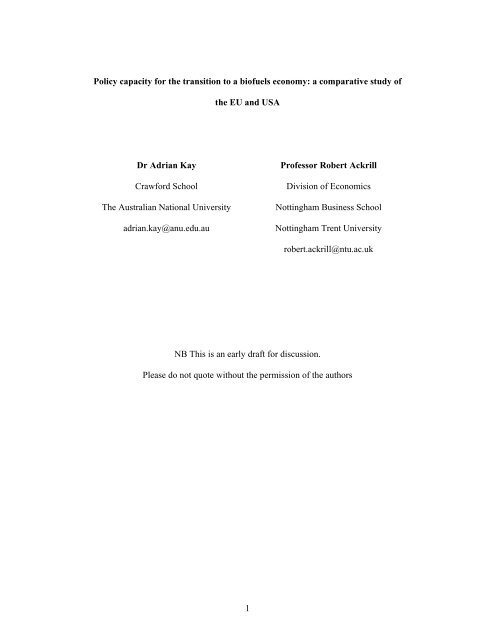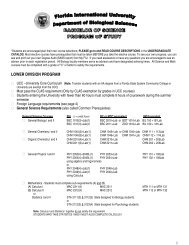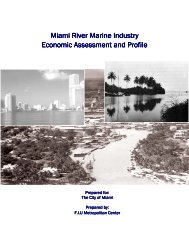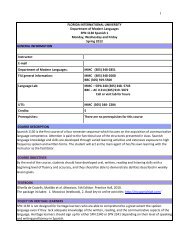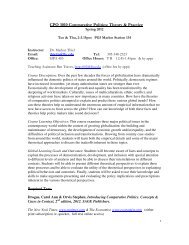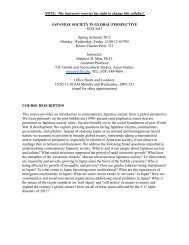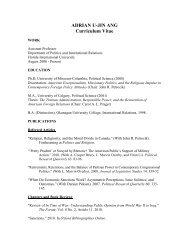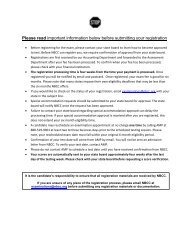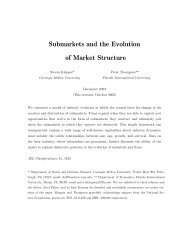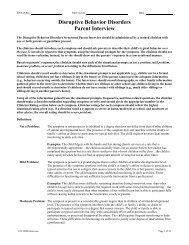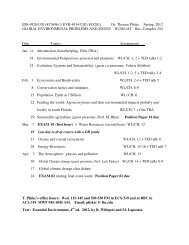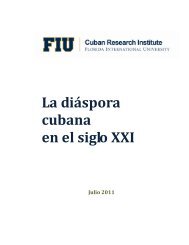Dr. Ackrill paper (*.pdf)
Dr. Ackrill paper (*.pdf)
Dr. Ackrill paper (*.pdf)
You also want an ePaper? Increase the reach of your titles
YUMPU automatically turns print PDFs into web optimized ePapers that Google loves.
Policy capacity for the transition to a biofuels economy: a comparative study of<br />
the EU and USA<br />
<strong>Dr</strong> Adrian Kay Professor Robert <strong>Ackrill</strong><br />
Crawford School<br />
The Australian National University<br />
adrian.kay@anu.edu.au<br />
NB This is an early draft for discussion.<br />
1<br />
Division of Economics<br />
Nottingham Business School<br />
Nottingham Trent University<br />
robert.ackrill@ntu.ac.uk<br />
Please do not quote without the permission of the authors
Introduction<br />
The scale of the challenge to the policy capacity of the modern state of decoupling<br />
emissions growth from energy consumption in the economy is formidable. Indeed, the<br />
scale of the ambition runs counter to several decades of public administration debates<br />
and literatures on government overload, the shift from government to governance, the<br />
hollowed out state and government failure. The concept of policy capacity is<br />
variously defined, and enjoys currency because it encompasses two linked governance<br />
concerns; (i) the recognition of increasingly complex interdependence in the<br />
international economy imposing limits on traditional government activity, and (ii) a<br />
prominent discourse about the development of steering capacity as an essential feature<br />
of effective, contemporary governing (Osborne and Gaebler 1992; <strong>Dr</strong>or 2000).<br />
Transport biofuels are an early and influential case of the policy capacity challenge in<br />
the transition to low-carbon economies. Notably in standing analytically for the<br />
situation where longer term policy goals must be both clearly enunciated and remain<br />
viable over time as credible commitments, even though considerable flexibility and<br />
adaptability in policy-making is required to reach those far horizon goals under<br />
conditions of high technological and market uncertainty. In such terms, policy is an<br />
intertemporal choice in which there is capacity for the benefits of a low carbon future<br />
to enter current policy processes; because if the pathway to their achievement is<br />
uncertain and politically contested in the implementation phase, then those future<br />
benefits may be heavily discounted, shortening policy-maker horizons and rendering<br />
the overall transition process politically vulnerable.<br />
2
The first part of the <strong>paper</strong> presents a review of the recent literature on policy capacity<br />
in order to adumbrate five critical dimensions of policy capacity with respect to the<br />
challenge of governing the transition to a low carbon economy. The second part sets<br />
out liquid transport fuels as an important example of this challenge by providing a<br />
comparison of EU and US biofuels policy-making – both design and implementation -<br />
over the last decade, drawing on qualitative data from semi-structured interviews<br />
recently undertaken with leading policy actors in both jurisdictions.<br />
The third part of the <strong>paper</strong> locates the EU and US processes on the policy capacity<br />
schema set out in part one. It also introduces evidence from thirty years of Brazilian<br />
biofuels policy-making as a point of contrast; here policy capacity in biofuels<br />
consumption is much more developed. The dimensions of policy capacity offered in<br />
the present <strong>paper</strong> offer a means to identify and analyse key processes in biofuels<br />
policy-making in the EU and US, even if they fall short of a valid and reliable<br />
measurement of policy capacity. By investigating a policy sector that overlaps<br />
agriculture, energy and transport policy fields, this <strong>paper</strong> is able to offer distinctive<br />
public administration insights into the feasibility of environmental policy integration<br />
to achieve sustainability goals, widely advocated in the specialised field of<br />
environmental studies (e.g. Dovers 2001, 2005; Buhrs 2009).<br />
Policy capacity for the transition to a low carbon economy<br />
The salience of the ambition to build policy capacity is related to Osborne and<br />
Gaebler’s (1992) oft-invoked view that governments ‘steer and do not row’ in the<br />
contemporary international political economy. Parsons (2004, p.44) develops a<br />
nautical version of the steering metaphor, arguing that map-making and navigating are<br />
3
core elements of the capacity to govern, ‘the ability to chart the voyage, plot<br />
coordinates, set direction and take a long term view – in short, to navigate.’ The<br />
academic literature on policy capacity offers subtle definitional variety. An indicative<br />
selection includes the ability of governments to make intelligent choices (Painter and<br />
Pierre, 2005); to scan the horizon and set strategic directions (Howlett and Lindquist,<br />
2004); the faculty to weigh and assess the implications of policy alternatives (Bakvis,<br />
2000), as well as aptitude in making the effective use of appropriate knowledge in<br />
policy-making (Parsons, 2004; Bakvis and Aucoin, 2005).<br />
Davis (2000) makes specific reference to the ability of governments to implement<br />
preferred choices of action as well as decide upon them, which introduces the cognate<br />
concept of policy co-ordination or coherence which is rooted in the same set of<br />
concerns as policy capacity (Di Francesco 2001; Bardach 1998; Rhodes 1997).<br />
Parsons (2004) describes this dimension of policy capacity as the ‘weaving’ function<br />
of modern governments, the ability to weave together the multiplicity of organisations<br />
and interest to form a coherent policy fabric, which is robust enough to survive the<br />
politics of policy implementation.<br />
We extract five specific dimensions from the literature on which to dissect<br />
analytically and specify policy capacity in terms of governing a transition to a low<br />
carbon economy. These are introduced here and will be employed in part three, in the<br />
analysis of the data available in the case of biofuels policy-making.<br />
Value agreement capacity<br />
4
This dimension refers to the facility of government in reaching agreement about the<br />
values that underpin policy. This contributes to policy capacity by enabling<br />
governments to introduce significant policy changes without risking societal backlash<br />
and electoral defeat. This feature of policy capacity is noted in the advocacy coalitions<br />
literature (Sabatier 1987; Sabatier and Jenkins-Smith 1993). However, as<br />
contributions in Adger and Jordan (2009) suggest, this may be an unrealistic standard:<br />
many areas of the governance of sustainability are marked by conflicting values and<br />
sharply divided public attitudes. Here the capacity of policy-makers is better<br />
understood in terms of managing the conflicts inevitably arising from the<br />
incommensurable values involved in the transition to a low carbon transport fuel mix.<br />
Selection capacity<br />
Following the literature, this dimension is the varying ability of governments to forge<br />
authoritative choices which commit relevant governmental and social actors, notably<br />
private enterprises in the case of biofuels, to implementing policy alternatives. As the<br />
environmental policy literature suggests, the goal of sustainability imposes a set of<br />
requirements across a wide set of cognate policy areas. This leaves governments with<br />
the challenge of coherent, joined-up policy making in a context where power may be<br />
diffuse, political consensus difficult to achieve and implementation requires strong<br />
co-ordination between multiple policy and market activities.<br />
Operational capacity<br />
A key proposition emerging from the network governance literature is that open and<br />
inclusive policy networks, although fluid in membership and often difficult to<br />
institutionalise, actually contribute to effective policymaking because they are able to<br />
5
absorb complexity and are more resourceful and resilient in delivering outcomes than<br />
closed and exclusive networks (see, for example, Bovens et al., 2001, Klijn and<br />
Koppenjan 2004). Policy-makers trying to effect a transition to a low carbon economy<br />
must deal with political, technological and market uncertainties that require they act<br />
within existing sector-specific networks, as well as across different networks that are<br />
being linked by novel biofuel policy agendas.<br />
Foresight capacity<br />
The ability of governments to look forward and anticipate is often doubted, and the<br />
attribution of myopia brought about by electoral timetables or media cycles is<br />
common. However, even amidst pervasive uncertainty, effective policy-making<br />
requires a capacity to identify ‘known unknowns’ in order to map a future path for<br />
policy. Foresight is a distinct dimension of policy capacity; for analytical purposes,<br />
there is a relevant difference between unconscious and conscious incompetence<br />
amongst governments. Understanding the capacity to anticipate potential political as<br />
well as private enterprise ‘hold up’ problems is important independent of evidence of<br />
the ability to resolve them.<br />
Reflection capacity<br />
Even if the far policy goal (defined as part of a government’s Foresight Capacity) is<br />
fixed, Reflection – as a map-reading exercise – requires governments to monitor on an<br />
on-going basis where they have come from, where they are going, and how they<br />
might get there. This dimension encompasses the faculty for detecting problems with<br />
current policy settings (Deutsch (1963), Argyris and Schon (1978)), as well as the<br />
ability to learn both cross-nationally and longitudinally in order to respond to<br />
6
evidence of failings. The capacity of policy-makers to avoid mere ‘muddling through’<br />
behaviour when faced with existing policies identified as ineffective and/or unpopular<br />
(Klein 2009) is an important element of the steering mechanism available to<br />
governments. The extent to which the policy-making system as a whole has access to,<br />
and can utilise, institutions that allow current policies to be critically examined, to<br />
look back to recover historical lessons and scan the international horizon for<br />
alternative policy change options is constitutive of policy capacity.<br />
Strategies governing the transition to a biofuels economy in the EU and US<br />
In both the EU and US, biofuels policy over the last decade represents the<br />
transformation of a relatively minor, niche aspect of energy policy into a central,<br />
economy-wide plank of future energy strategy in the transport sector. Despite their<br />
dissimilarities as political systems and the dissimilar constellation of political interests<br />
in sustainability policy, both jurisdictions arrived at a shared objective, at roughly the<br />
same time, of promoting a dramatic increase in the production and consumption of<br />
biofuels in the liquid transport fuel market. This section compares the processes of<br />
policy design in both jurisdictions that lead to this common objective; as well as their<br />
experiences in policy implementation, including the processes of error adaptation,<br />
learning, new political alliance formations, as well as shifts in the broader policy<br />
environment which have all contributed to test the policy capacity of the EU and US<br />
in the implementation of biofuels policy.<br />
Policy Design<br />
The salient episodes in the two biofuels policy processes under scrutiny are the<br />
enactment of the US 2007 Energy Independence and Security Act (EISA) and the<br />
7
EU’s 2009 Renewable Energy Directive (RED), the latter being part of a ‘climate and<br />
energy package’ consisting of several Directives. Each of these two pieces of<br />
legislation builds on earlier policy initiatives reaching back to the 1970s in both<br />
jurisdictions and various responses to the extreme oil and commodity price volatility<br />
of that decade. However, for the subsequent twenty or so years, biofuels remained a<br />
niche concern in US and EU energy policy. It is the ambition to increase biofuels<br />
consumption in the US after the Energy Policy Act 2005 and in the EU with the 2003<br />
Biofuels Directive that act as the proximate bases for the 2007 and 2009 policy<br />
adoptions.<br />
Both EISA and RED impose mandates for the use of renewable fuels in transport well<br />
above current domestic production levels and above the levels set down in the earlier<br />
legislation. Moreover, to help delivery of policy goals both turned to mandates rather<br />
than rely on the ultimately-ineffective voluntary biofuel usage targets of the earlier<br />
legislation. The EISA and RED also involve – in implementation – the development<br />
of sustainability criteria that need to be met before supplies can be counted as<br />
contributing towards the mandated figure. These mandates represent a significant part<br />
of expected liquid transport fuel consumption (most of the 10% renewable target in<br />
the EU by 2020, and 36 billion gallons in the US by 2022, which could equate to 20-<br />
25% of liquid transport fuel consumption).<br />
In the US policy design, this 36 billion gallon mandate is divided explicitly between<br />
different types of biofuel. 21 billion gallons are mandated to come from advanced<br />
biofuels (capable of delivering at least a 50% reduction in GHG emissions, as<br />
opposed to 20% for conventional (eg corn-based) ethanol. Of those 21 billion gallons,<br />
8
at least 16 billion must come from cellulosic biofuels; and at least 1 billion must come<br />
from biomass-based diesel. The remaining 15 billion gallons can come from either<br />
conventional or advanced ethanol.<br />
The general energy policy ambition to reduce reliance on oil has particular resonance<br />
in the transport sector, and is one of the reasons why biofuels attract attention as an<br />
early policy step towards a more sustainable economy. In both the US and EU it is<br />
forecast to be a major source of future carbon emissions increases. Currently, the US<br />
transport sector accounts for around a third of total energy demand in the US and oil<br />
provides upwards of 95% of energy consumed in the sector. As for the EU, according<br />
to Kavalov (2004) transport, at that time, represented 50% of energy consumption<br />
imports, but this could rise to 70% by 2030. Transport also represented 32% of all<br />
energy consumed, 98% of which was oil-based (equivalent to 67% of EU final oil<br />
demand). Transport generated 28% of EU CO2 emissions, but is expected to be the<br />
source of 90% of the projected increase in CO2 emissions.<br />
Our primary research suggests multiple reasons were active in binding different<br />
advocacy coalitions together in favour of a policy to expand biofuels production;<br />
however, these differing reasons implied quite different types of biofuels policy. This<br />
ambiguity in policy objectives was accommodated by adopting a policy design in<br />
which there was a demarcation between first generation and advanced biofuels; in<br />
essence, both the US and EU introduced two different types of policy to satisfy the<br />
incommensurable values in the policy process. This distinction between first<br />
generation and advanced biofuels is explicit in the US mandate, as noted above. In the<br />
EU advanced biofuels count double towards the usage mandate, but the role foreseen<br />
9
for advanced biofuels is more implicit. That said, our primary research revealed a<br />
range of projects aimed at developing and bringing to market advanced biofuels,<br />
albeit without specific target dates or roles within the biofuels mandate.<br />
Policy implementation<br />
Although designed to promote domestic policy objectives, the biofuels policy<br />
environment has attracted the attention of non-domestic political actors in the<br />
implementation phase: international institutions like the OECD, international research<br />
institutes such as IFPRI with a focus on trade and development, and advocacy groups<br />
of non-state actors organised cross-nationally. This was manifest in the politics<br />
around the world food price spike in 2008 – and the resulting international opposition<br />
to biofuels – which came as biofuels production was accelerating (total world<br />
production of BF trebled 2000 and 2007).<br />
There were also specific market factors for expanding ethanol demand, related to<br />
MTBE Methyl Tertiary Butyl Ether (MTBE). 1 It is also worth noting that this take-off<br />
followed a period of oil price rises: from the start of 2003 to the middle of 2006, crude<br />
oil prices rose by 2.5 times, falling back to (just) double January 2003 levels at the<br />
start of 2007, rising to 4.5 times January 2003 levels by the middle of 2008. The<br />
higher the price of oil, the more likely biofuels are to be cost competitive, even<br />
1 MTBE and ethanol were both used as oxygenates in gasoline. The 1990 amendments to the US Clean<br />
Air Act mandated the use of oxygenates in areas with high air pollution levels. Growing concerns over<br />
groundwater pollution by MTBE led, in 2005, to the removal of MTBE liability protection and the<br />
removal of the obligation to include oxygenates in gasoline. Interviews revealed that, given this latter<br />
policy change and partly in response to lobbying from the corn and ethanol sectors, the Energy Policy<br />
Act introduced the Renewable Fuel Standard as a way to maintain policy support for ethanol.<br />
10
without subsidies. It is estimated that Brazilian sugarcane ethanol can compete with a<br />
crude oil price of around $45 a barrel. With corn ethanol, a corn price of $2 a bushel<br />
is competitive with oil at around $50-60 a barrel, although if the corn price rises to $4,<br />
oil would have to be closer to $120 for ethanol producers to be able to buy the corn<br />
and still break even on their ethanol.<br />
The international scrutiny of biofuels policies is related to their entanglement with<br />
many different societal values (energy, the environment, economic development,<br />
agriculture, and trade). The unprecedented media scrutiny over the first seven months<br />
of 2008 to the role of biofuels in the global South’s food security crisis brought<br />
international attention to biofuels policy in the US and EU; and shaped the<br />
implementation politics by directing attention to the impact of biofuel production on<br />
food security and the heightened incentives to convert lands in the developing south<br />
to biofuels production. This sits alongside environmental sustainability, with various<br />
attempts (from both inside and outside of government) to model the net energy benefit<br />
of biofuels over their life cycle versus conventional fossil fuels, including the direct<br />
and indirect land use impacts of biofuels on GHG emissions (see, for example,<br />
Searchinger et al. 2008; Bouët et al. 2010; Edwards et al. 2010, the last comparing<br />
multiple models and their results).<br />
Although these models are subject to controversy, their impact is to suggest to policy-<br />
makers that greater environmental gains will come from advanced biofuels whose<br />
GHG savings are larger, and which avoid the food-fuel trade-off. This reinforces the<br />
panaceaic properties assigned to advanced biofuels; they perform the function of<br />
separating incommensurable values in the policy process and assuaging opposition to<br />
11
iofuels by promising that any harmful effects will be dissipated by technological<br />
change in the advanced biofuels policy. This is an important element in the deliberate<br />
tolerance of ambiguity of policy goals, in combination with the conscious design of<br />
market and technological uncertainty into the policy process.<br />
Reflecting at this point on Brazilian ethanol policy, one significant point of difference<br />
is the absence of production or consumption mandates, other than the setting of a<br />
blending percentage for ethanol in gasoline. The programme of liberalisation through<br />
the 1990s which embedded a free-market philosophy in Brazil, the cost<br />
competitiveness of Brazilian sugarcane-based ethanol against gasoline, and the<br />
maturity of the domestic ethanol market, are all likely factors precluding or obviating<br />
the use of mandates as deployed by the EU and US.<br />
That said, a market development in Brazil that, coincidentally, also happened in 2003,<br />
was crucial: The introduction of flex-fuel vehicles (FFVs). These can be fuelled using<br />
any combination of gasoline and E100 a driver chooses. Economic liberalisation<br />
removed sugarcane production quotas, a move which resulted in an expansion in<br />
sugarcane production sufficient to produce greater quantities of sugar and ethanol. On<br />
the demand side, FFVs boosted ethanol use per se. In a liberalised marketplace, both<br />
supply and demand of ethanol respond to market signals, such as ethanol prices<br />
relative to sugar prices (on the supply side) and oil prices (on the demand side). There<br />
are variations in taxes on different types of fuel and in different states, but demand<br />
and supply of ethanol in Brazil are essentially subject to market forces.<br />
12
It is important to contrast this with the situation of Brazil’s emergent biodiesel market.<br />
Here, whilst the market remains essentially free, it is underpinned by a series of<br />
measures designed to help it establish. In this regard, there are some similarities with<br />
US and EU markets and policy. A gradually-rising blend percentage is specified on<br />
the demand side, in the context of a country where demand for diesel is expected to<br />
double in ten years. This is further underpinned by biodiesel auctions. On the supply<br />
side, a system of contracts is enforced to ensure the biodiesel blenders obtain a<br />
quantity of biodiesel feedstocks from small producers at terms conducive to<br />
delivering the social goals the Brazilian government has set for the policy. Thus, in<br />
Brazil, minimum prices are enforced to deliver social goals on the supply side, rather<br />
than using delivery mandates, subsidies or tax breaks to stimulate demand.<br />
Assessment of policy capacity in the transition to a biofuels economy<br />
Value agreement capacity<br />
The development of biofuels policies in the EU and US has been underpinned by<br />
reference to common factors, albeit with varying emphasis reflecting different<br />
domestic political constituencies. The three dominant factors have been energy<br />
security, climate change mitigation and rural development. In the US, the greatest<br />
emphasis has been given to energy security. In practice this means reduced imports of<br />
Middle Eastern oil (noting also the tariffs on imported biofuels). This has had<br />
particular resonance in the context of 9/11 and the subsequent military engagements<br />
in Afghanistan and Iraq. EU policy has referenced energy security but, with limited<br />
domestic production capacity relative to longer term mandates, the emphasis has been<br />
more on diversifying imports, in terms of both fuels and source countries.<br />
13
US policy has referenced climate change mitigation, for example in later State of the<br />
Union Addresses given by President Bush Jr. In the EU, however, this has had greater<br />
emphasis, especially with the role the EU has given itself as a global leader in climate<br />
change politics and policies (see, inter alia, Oberthür and Pallemaerts, 2010; Wurzel<br />
and Connelly 2010). Rural development has also played a notable, but arguably a<br />
subordinate, role in the EU and US. That said, related to the greater domestic<br />
production potential of biofuels feedstocks in the US, there has been relatively more<br />
emphasis placed on biofuels as an aspect of agricultural policy than in the EU.<br />
The political tensions inherent in the value conflict between rural development,<br />
energy security and climate change mitigation have been exacerbated by a<br />
commercial environment characterised by market uncertainty (price of oil, commodity<br />
prices) alongside extreme technological uncertainty about the blend wall for first<br />
generation ethanol (in the US) and the feasibility of industrial scale production of<br />
advanced biofuels (in the US and EU).<br />
Thacher and Rein (2004) provide a typology of practical solutions to managing value<br />
conflicts in policy-making (see also Stewart 2009); the US and EU biofuels cases<br />
reveal a novel variant of the structural separation or firewalling strategy, where value<br />
conflict is mitigated through organisational design: different public organisations<br />
involved in a policy are guardians of different values. In the biofuel cases, the novelty<br />
exists in policy designed to separate conflicting values intertemporally. In both the US<br />
and EU, there are short to medium term goals of increasing the production of first<br />
generation (1G) biofuels, alongside longer term goals for advanced biofuels<br />
production.<br />
14
Politically, the advanced biofuels policy element functions as a superordinate policy<br />
goal to describe the overall direction of travel. This helps to persuade those concerned<br />
with values of food security and ecological sustainability to tolerate large increases in<br />
first generation biofuel production – which use known agricultural feedstocks, with<br />
associated land use changes and food production effects – as a necessary bridging step<br />
to an advanced biofuels economy. Reflecting this intertemporal aspect of policy,<br />
mandates increase certainty for those investing in advanced biofuels technologies; but<br />
also seek to commit future policy-makers to the values (and policies) determined in<br />
the present.<br />
The two-part policy design enacted in both jurisdictions has had to evolve in<br />
implementation due to endogenous tensions associated with technological and market<br />
uncertainties, as well as, since 2008, significant shifts in the broader policy<br />
environment. Neither the EU nor the US have solved the problem of reconciling the<br />
ambiguity of policy values by the 1G/advanced biofuels design separation. The novel<br />
requirements of environmental sustainability have begun to enter into the 1G policy<br />
debate rather than being confined to the advanced biofuels element, expressed for<br />
example in concerns around the net energy benefits of biofuels on a life cycle analysis<br />
accounting for direct and indirect land use changes (DLUC and ILUC). Relatedly,<br />
pressures grew on policy-makers and pro-biofuels advocacy coalitions from rising<br />
food prices in 2008, precipitating the emergence of large scale international<br />
opposition to biofuels production, as well as a strong ‘food before fuel’ campaign in<br />
the US.<br />
15
The key design feature of policy in both jurisdictions in accommodating ambiguity in<br />
policy goals, through a sequence of temporal targets to guide the transition to mass<br />
biofuels consumption, alongside profound market and technological uncertainties<br />
about the feasibility of the targets, has set the conditions for implementation politics.<br />
In both jurisdictions the demand side policy was enacted without coordination with<br />
supply availability, import security concerns, sustainability concerns and with<br />
substantial hope invested in the development of an industrial-scale, commercially<br />
viable advanced biofuels industry. Furthermore, in the implementation phase land use<br />
change requirements and the demands of WTO rule compliance have entered the<br />
policy process but without their potential constraint on policy being institutionalised.<br />
Selection Capacity<br />
Recent work by Patashnik (2008) on the political dynamics of major reforms offers<br />
insights into the factors which explain why some reforms stick and others are<br />
unpicked. In particular, reforms that endure through the implementation process<br />
typically destroy an existing policy subsystem and reconfigure the political dynamics.<br />
This insight is highly relevant to the ability to commit societal actors to a policy<br />
direction, or selection capacity in our terms. Biofuels is a new policy domain in the<br />
EU and the US (at least in terms of its political salience), and overlaps with several<br />
existing policy domains with their own particular networks and legacies. The policy<br />
capacity challenge is to be able to reorganise these in the direction of achieving long<br />
term mandates for biofuels use.<br />
The conflict between interests/actors in the biofuels processes under scrutiny were not<br />
resolved in a single policy act, but rather have continued beyond adoption or<br />
16
enactment. The two-part biofuel policy design (1G/advanced) enacted in both the US<br />
and the EU was a strategic move to commit to - or ‘select’ - a path in a dynamic<br />
policy system rather than a one-off choice in some classic textbook way. The promise<br />
or foreshadowing of a radically changed policy environment, notably a mass market<br />
and international industry in biofuels, has provided policy logic in the system, and<br />
favours some interests or values over others. Nevertheless, this selection has not<br />
determined uniquely the subsequent policy path, which instead remains open and<br />
contingent to shifts in policy preferences which arise from political competition.<br />
There are important intertemporal dimensions in both jurisdictions in terms of<br />
selection capacity. The strategy has been to agree policy objectives in the short term,<br />
and accommodate different and conflicting values involved in biofuels expansion by<br />
legislating guides to future policy change in the advanced biofuels sector. This<br />
adoption of two separate types of biofuels policy has precipitated a distinctive<br />
implementation situation. There is a superordinate goal of a substantial biofuel<br />
component in the liquid transport fuel market but there is no explicit policy guidance<br />
over the sources of future advanced biofuels, only complementary superordinate<br />
constraints such as sustainability criteria, discussed below. Uncertainty over what<br />
industry actors are willing and able to deliver raises the question of whether, and how,<br />
this acts as a constraint on the evolution of policy, in which actors are committed to a<br />
certain policy direction?<br />
The early 2000s marked a profound watershed in US ethanol policies. Following the<br />
9/11 terrorist attacks President Bush, in every subsequent State of the Union Address,<br />
referred to the need for the US to reduce its dependence on imported oil. The 2005<br />
17
Energy Policy Act, partly in response to changes in the policy on oxygenates in<br />
gasoline, introduced the RFS to create a (voluntary) usage target for ethanol. This was<br />
followed, just two years later, by a shift to usage mandates in the EISA, introduced<br />
via RFS2.<br />
In the EU, 2001 saw the publication of proposals for what would become the 2003<br />
Biofuels Directive. This had complex roots in ongoing policy discourses on<br />
sustainable development, the Lisbon Strategy and the embedding of environmental<br />
considerations into a range of common EU policies. As with the US, initial voluntary<br />
biofuels usage targets were replaced soon after (2009 in the case of the EU) with<br />
mandated usage targets. In both jurisdictions, the mandates represented a significant<br />
increase in the targets over the previous voluntary targets; but for a policy to be<br />
delivered over a longer timeframe. Mandates, as already noted, help increase investor<br />
certainty and seek to bind future policy-makers. This would be consistent with<br />
Parsons’ notion of ‘weaving’, discussed above. It also creates increasing returns<br />
pressures in path-dependent policy processes.<br />
This is highly pertinent to the biofuels case, as our analysis of the data shows that<br />
reformers’ attention has waned in the US (for example, key individuals in the Senate<br />
– Daschle, Dole and Grassley – are gone or less influential) and in the EU, that the<br />
initial spirit of the reforms that held the reform coalition together has been contested<br />
by novel, unanticipated concerns in the implementation process. Notably, both the US<br />
and EU cases reveal that the discourse of sustainability, far from helping to integrate<br />
various policy objectives in the implementation phase in a common concern, can (i)<br />
add complexity to initial policy design, and increase the number of objectives,<br />
18
interests and players in policy implementation; (ii) be used as a key resource by<br />
institutionally-embedded actors in existing policy legacies to protect their autonomy<br />
against the ambitions for a coordinated implementation of the initial policy design.<br />
Of course policy is always made under conditions of uncertainty, but the degree of<br />
market uncertainty and technological uncertainty that attends biofuels policy is central<br />
to selection capacity. For example, ethanol in the US is a valid outlet for some of the<br />
‘awful lot of corn’ produced there, whilst ethanol and biodiesel are valid outlets for<br />
EU agricultural production, in the context of a decoupled CAP. These are ‘market’<br />
reasons for this use of US/EU feedstocks that exist independently of ‘policy’ reasons.<br />
Policy is being implemented in conditions where various agricultural commodity<br />
markets are volatile, oil prices likewise, competition domestically and internationally<br />
is variable, in the context of a credit crunch for capital. Thus in trying to create<br />
appropriate incentives for a new biofuels industry, policy settings are not the only<br />
relevant factor (nor indeed perhaps the dominant factor).<br />
Operational capacity<br />
The design of biofuels policy in both jurisdictions requires flexibility and adaptation<br />
in operation, to ensure success in meeting the 10 year and longer targets. In the US,<br />
1G ethanol is restricted by the blend wall. Advanced biofuels are limited by the lack<br />
of domestic commercial production – although that target could be met through<br />
imports of, for example, Brazilian sugarcane-based ethanol. Currently, the policy<br />
response to the blend wall is to seek agreement on raising the ethanol blend<br />
percentage in gasoline; whilst, for advanced biofuels, the current response is for the<br />
EPA simply to reduce the annual targets in RFS2, in line with estimated production<br />
19
each year. There are already several million FFVs on the road in the US, but<br />
interviews indicate this is in response to tax breaks and thus lower purchase prices;<br />
meanwhile availability of E85 remains limited and relatively localised.<br />
The EU mandate target of 10% of transport fuel from renewables in 2020 is somewhat<br />
more modest than the US target, perhaps half of the US figure, based on current<br />
projections for US gasoline demand for 2022 (although the environmental impact may<br />
offset this, given the greater GHG emissions reductions demanded in EU policy).<br />
Given also that the mandate does not distinguish between ethanol and biodiesel,<br />
offering both flexibility in delivery and reducing potential ethanol blend wall<br />
concerns, the EU target appears, currently, to be more achievable. Countries’ progress<br />
towards their individual targets, however, remains mixed at this stage (European<br />
Commission, 2011).<br />
Given the current status of debate in the US over the blend wall, a significant<br />
exportable surplus of ethanol is emerging from what was intended primarily as a<br />
domestic policy. Furthermore, whilst the policy specification of advanced biofuels<br />
includes Brazilian sugarcane ethanol, Brazil has recently become an ethanol importer,<br />
given cane production levels and price developments on the sugar market. In the EU,<br />
however, domestic production potential has meant its mandate would always require<br />
imports. Despite this, neither Brazil nor the US policy pursues production explicitly<br />
for export: both simply export such quantities as may be available. It is beyond the<br />
scope of the present <strong>paper</strong> to analyse market developments in other countries where<br />
production may have been promoted specifically for export to the EU. At the time EU<br />
20
policy was being developed, however, the understanding that imports would be<br />
needed was not matched by knowledge of where those imports were to come from.<br />
Beyond trade concerns, we consider also the extent to which domestic biofuels<br />
policies are influenced by transnational politics. Our data on the scope of the networks<br />
in which the EU and US are actively involved casts doubt on the extent to which<br />
domestic biofuels policies are immutably subject to the influence of transnational<br />
politics (cf. Skogstad 2010). The principal inter-governmental biofuel body is the<br />
Global Bioenergy Partnership (GBEP). Interview data reveal very little transnational<br />
political impact on domestic policies in this forum. Instead, for example, it provides a<br />
forum for countries to ‘learn about’ each other’s jurisdictions, policies, the repertoires<br />
of instruments and methods, rather than representing epistemic communities in a Haas<br />
(1992) sense. The domestic politics are so competitive it seems that this ‘soft’ power<br />
is attenuated and does not redistribute existing power in the policy system.<br />
A notable difference between US and EU experience does arise, however, as a result<br />
of the different trade needs arising out of their domestic biofuel usage mandates. Our<br />
interview data from policy-makers in the US reveals very little evidence of a direct<br />
transmission belt from the ideas, strategies and activities of transnational political<br />
actors to domestic politics. In contrast EU policy, with its need for imports, has had to<br />
face a series of significant transnational issues. Given GHG emissions reductions is a<br />
central part of EU policy, there is a need to ensure the production of all biofuels<br />
feedstocks contributing to biofuels consumed in the EU avoids conflict with this goal.<br />
As a result, a system of policy measures is having to be developed regarding the<br />
21
production conditions of feedstocks, whilst remaining consistent with WTO rules on<br />
trade barriers.<br />
There is strong evidence that EU sustainability criteria have been developed with<br />
WTO rules expressly in mind. Moreover, transnational political engagement is<br />
expressly part of the guidance offered to countries in the WTO Technical Barriers to<br />
Trade Agreement (TBTA) when developing such criteria (<strong>Ackrill</strong> and Kay, 2011).<br />
Prior to drawing up legislative proposals for the sustainability criteria, a consultation<br />
process was held to which anybody, including third country governments, could<br />
contribute. Consultation also involved engagement over the certification process for<br />
producers that could ensure approved sources delivered feedstocks – and thus,<br />
ultimately, fuel suppliers could deliver transport fuel – that conformed with those<br />
sustainability criteria.<br />
There are various national and international Roundtables, in which a variety of<br />
economic and civil society actors work together in defining what sustainable biofuels<br />
are or should be, what could/should private actors do to move in that direction, and<br />
how this can be certified and verified (Verdonk et al. 2007, Mol 2010, van den<br />
Hombergh 2008). Direct engagement between governments and Roundtables is key<br />
where the practical requirement of aligning certification schemes of the latter with<br />
importer government standards sets the biofuels trade policy agenda.<br />
For example Bonsucro (formerly the Better Sugarcane Initiative) developed a general<br />
sugarcane production-standard, to which was added a small number of additional<br />
elements when developing an EU-compliant standard. Moreover, the Roundtables’<br />
22
certification function helps promote sustainability production independent of biofuels<br />
concerns. Products such as palm oil certified by the Roundtable on Sustainable Palm<br />
Oil (RSPO) are gaining market credibility in the eyes of industrial buyers and,<br />
ultimately, final consumers. This is helping spread the use of RSPO certification<br />
procedures globally.<br />
The differences between EU and US engagement with such transnational actors<br />
reflect the different trade implications of biofuels mandates. In Brazil, meanwhile, the<br />
government’s position has been to engage with the EU during the process establishing<br />
legislation on sustainability criteria. It has avowedly not, however, supported or<br />
promoted domestic producers’ involvement with certification schemes. It has<br />
remained neutral, a position from which (interview data reveal) it can best monitor<br />
policy implementation to ensure WTO-compliance in the policy-enactment phase.<br />
Overall, therefore, we have found evidence of transnational political networking<br />
activity by policy-makers, but in political terms the influence of this work is<br />
attenuated, certainly relative to domestic networks and their impact on domestic<br />
policies. Identifying a lack of operating capacity at the transnational scale, particularly<br />
in political terms in the form of inter-governmental influence, is an important finding.<br />
One interpretation is that at the present stage of the development of biofuels policy,<br />
the construction of domestic operating capacity is of paramount importance.<br />
Moreover we may assume that, a priori, this is less challenging politically than<br />
constructing operational capacity on a transnational scale. As noted earlier Value<br />
23
Agreement was undertaken by means of emphasising aspects of biofuels policy to<br />
which domestic constituencies would be most receptive.<br />
Another important aspect of governments’ operational capacity is the ability to<br />
respond to changes in market conditions. Expansion of trade, changes in the direction<br />
of trade flows, and concerns over sustainability, all raise the possibility that domestic<br />
policies could be affected in increasing ways by transnational politics. The question<br />
then becomes how those transnational factors might influence domestic policy change<br />
and, thus, domestic policy-makers’ capacity to accommodate and deliver such change<br />
(this also embraces Reflection Capacity, considered below). For example, were a<br />
certification scheme to gain a global foothold that was inconsistent with an importer’s<br />
sustainable production standard, network effects around the adoption of such a<br />
standard in different markets may potentially be sufficiently powerful that importers<br />
may just have to submit to the private sector standard: public governance may, in<br />
some cases, have to adapt to developments in private governance.<br />
In considering the co-ordinating mechanisms to implement the policy in each<br />
jurisdiction and how this has left both policy areas susceptible to fragmentation<br />
through sustainability concerns (which, in turn, have different meanings and scope in<br />
the EU and US), the initial policy design is brought into analytical focus. This<br />
included various policy objectives – implicitly and explicitly – such as rural<br />
development, energy security, and GHG emissions reduction that were managed<br />
intertemporally. This strategy required the bridge between the two stages, of 1G and<br />
advanced biofuels, to be credible for co-ordinated implementation. Without this,<br />
spillovers between the different temporal dimensions of the policy may arise and<br />
24
values conflict as their incidence is distributed among different policy legacies that<br />
might have an interest in biofuels policy.<br />
It may be self-evident to assert that the lack of co-ordination in policy design is<br />
positively related to lack of co-ordination in policy implementation. Yet this truism<br />
sits at the heart of the implementation dilemma for both the US and the EU: the need<br />
to remain credible about long term goals alongside ambiguity about the reasons for<br />
those goals and necessary uncertainty about the steps to their achievement.<br />
One policy issue that has been used by opponents of biofuels to challenge the policy<br />
goals, that raises questions about the internal consistency of domestic biofuels policies,<br />
and has exposed significant differences of opinion in different countries, is Indirect<br />
Land Use Change (ILUC). The increased global demand for biofuels results in an<br />
expansion of croplands used to produce the feedstocks for ethanol or biodiesel<br />
production. As farmers worldwide respond to this, pristine lands are cleared and<br />
converted to new cropland to replace the crops for feed and food that were elsewhere<br />
diverted to biofuels production. Because natural lands, such as rainforests and<br />
grasslands, store and sequester carbon in their soil and biomass as plants grow each<br />
year, clearance of wilderness for new farmland (locally or globally) translates as a net<br />
increase in greenhouse gas emissions. ILUC is thus the unintended consequence of<br />
biofuels demand on the GHG balance of a biofuel.<br />
As several interviewees noted, in its causal complexity ILUC is difficult to imagine,<br />
never mind measure. This complexity renders observation and direct measurement de<br />
facto impossible. Modelling is the only feasible approach, although determining the<br />
25
accuracy of such estimates is constrained by limited understanding of ILUCs causal<br />
complexity, whilst the absence of directly-observed ILUC effects means inevitably<br />
the real-world accuracy of ILUC cannot be determined. This shows how policy-<br />
making within the discourse of sustainability is never a settled process because of its<br />
expansive quality; different and novel dimensions constantly emerge, compared to<br />
something more limited (but nonetheless grand) like GHG reduction, whilst<br />
understanding and modelling capacity of these aspects continues to develop.<br />
Foresight Capacity<br />
To adapt a distinction in March (1978), policy-making always takes place in an<br />
environment of uncertainty about the consequences of action, but importantly also in<br />
an environment in which there is uncertainty about future preferences. What the study<br />
of policy, over many decades, has contributed clearly is that the assumption that<br />
policy preferences are stable over time, consistent, and exogenous to policy actions<br />
and their effects is not helpful in modelling the policy process. Instead preferences are<br />
often vague, unstable and inconsistent.<br />
With both the EISA and RED, there are explicit biofuels mandates (plus other targets,<br />
such as the US CAFÉ target for increasing average car fleet fuel efficiency). The<br />
EISA also contains explicit targets for the improved energy efficiency of Federal car<br />
fleets, as well as support for research into new technologies such as electric cars,<br />
advanced biofuels etc. In the EU, these measures are not contained in the RED, but<br />
support is provided via a range of thematic research programmes. In addition, there<br />
are other policy measures that are less explicit, yet continue to move energy usage and<br />
climate-change mitigation measures in a particular direction. This latter feature is not<br />
26
only a direct legislative effort, but also represents a contribution to a wider political<br />
discourse on energy and climate issues that continues to be contested.<br />
Although the present <strong>paper</strong> is focused primarily on transport biofuels, it is important<br />
to note that both US and EU biofuels policies exists in a wider energy and climate<br />
context. That said, one difference is the nature of targets in those other policy areas. In<br />
the EU, the 20-20-20 targets represent targets for GHG emissions reductions,<br />
renewable energy in the EU energy mix, and a reduction in overall EU energy usage;<br />
of which heat and power are important contributors. In the US, however, the Senate<br />
removed a House plan to require that, by 2020, electricity utilities delivered a<br />
minimum 15% of electricity derived from renewable sources, with up to 4 percentage<br />
points able to come from efficiency savings (Sissine, 2007: 2).<br />
In the EU, the institutional structure allows the European Commission, not subject to<br />
electoral cycles, to engage in more challenging ‘blue-sky’ policy thinking. It is<br />
already, for example, undertaking discussions about possible goals for energy policy<br />
by 2050. 2 However even if, in policy terms, the EU is working towards more<br />
challenging targets, and even if the discussions of policy in 2050 are not fully<br />
delivered, in both jurisdictions the legislation and the surrounding discussion are<br />
seeking to take policy in a certain direction. Even if it is two steps forwards, one step<br />
back, as the House/Senate disagreement over renewable electricity illustrated, that is<br />
still a net step forwards.<br />
2 http://ec.europa.eu/energy/strategies/2011/roadmap_2050_en.htm (accessed 5 July 2011).<br />
27
A further aspect of Foresight, as evidenced in EU policy, is manifest in an iterative<br />
approach to policy-making. The RED established EU biofuels policy with a usage<br />
mandate, but it was only in 2010 that the detailed sustainability criteria, referenced in<br />
the RED, were first published. Over a year later and discussions over ILUC continue.<br />
Interviews revealed sustainability criteria and ILUC were known about prior to<br />
agreement over the RED in 2009. This iterative approach to legislation may reflect<br />
Foresight in that the European Commission, in drawing up the proposed legislation,<br />
were aware of where the policy needed to get to, but also may have been aware of the<br />
political barriers they faced. Thus, rather than present risk averse policy-makers with<br />
a proposal that reached the end-point in one go, they chose instead to present the<br />
legislation a bit at a time, using ‘salami tactics’ (Zahariadis 2003:15).<br />
Reflection Capacity<br />
Given the problems facing policy-makers, outlined at the start of the previous sub-<br />
section, there is then the question of the ability of policy-makers to reflect on policies<br />
as implemented. Can inconsistencies between policy-as-designed and policy-as-<br />
implemented be identified and corrected? Can lessons be learned from past<br />
experiences and/or from experiences in other countries? In terms of the biofuels cases,<br />
it is the credibility of government’s commitment to longer term targets for biofuels<br />
use which lies at the heart of implementation politics; changes may be needed in order<br />
to maintain forward movement in the general direction of broad goals, even if they are<br />
implicit and unquantified. This requires a capacity for forward-looking Reflection.<br />
Our data reveal that the feedback processes from policy design to subsequent policy<br />
changes are not straightforward; they are an uncertain and volatile mixture of positive<br />
28
and negative. There is evidence of policy layering [add refs] in design; for example,<br />
biofuels policy clearly overlaps with, though it is much broader in scope than, the<br />
agricultural policy domain as it increases biomass demand i.e. for certain<br />
commodities as feedstocks, also ethanol production/refining generally in rural areas<br />
(most biofuel feedstocks are bulk-losing commodities).<br />
But policy layering in design needs to be complemented by analysis of its<br />
consequences in implementation. In particular, the interaction between different<br />
legacies and new interests can be observed in the lack of institutionalisation and co-<br />
ordination between the two parts of the design in the implementation phase. The<br />
biofuels cases are suggestive of the particular difficulties of joining up government in<br />
the new governance of sustainability. The two part policy designs that were enacted in<br />
the US and the EU immediately introduced a number of bureaucratic players in<br />
implementation. In the EU several Commission Directorates-General were involved:<br />
ENER, MOVE, ENV, CLIM and AGRI; in the US there was DoE, USDA, EPA and<br />
State – let alone the other stakeholders and interested actors involved in implementing<br />
policy. Furthermore, as noted, the emergence of new international organisations, such<br />
as GBEP, provide a forum for discussion between the major players in a more<br />
constructive and progressive manner than the traditional international<br />
intergovernmental organisation. Internally, however, the biofuels cases have revealed<br />
old interests have still been influential. With the RED, ENER held the pen; whilst in<br />
the US, RFS2 was driven through by the Senate.<br />
In both the EU and US, despite the use of policy mandates, we observe a biofuel<br />
policy bifurcation between an increasingly path-dependent 1G component and a still<br />
29
incoherent, uncertain and contested advanced component. In terms of technological<br />
uncertainty and policy implementation, the biofuels policy case is affected by<br />
uncertainty about parameters within existing technologies (e.g. blend walls, and<br />
viability of existing liquid transportation fuel infrastructure) as well as uncertainty<br />
about technological paradigm shifts to advanced biofuels. The potential consequences<br />
of this latter shift – something anticipated in existing policy design – for biofuels<br />
policy-making is so profound as to make its prospect something that adversely affects<br />
the institutionalisation of advanced biofuels policy; whilst the technological certainty<br />
of existing 1G biofuels production means that this element of US policy is relatively<br />
more joined up.<br />
The US corn-ethanol target for 2015 is likely to be met, without imports or adverse<br />
effects on domestic food prices, and with perhaps insignificant disruption to existing<br />
fuel distribution infrastructure (BUT only if the widely anticipated permission for E15<br />
by the EPA is forthcoming –which seemed to be expected around DC). But the<br />
growth in the biofuels market up to 2022 is designed to be in advanced biofuels. In<br />
the US, the different mandates in a sense represent different biofuels policies. So for<br />
the technological change hypothesis: 1G biofuels policy, less technological<br />
uncertainty and you get more co-ordinated policy. But even here, the E10/E12/E15<br />
blend wall debate is uncertain. Without an increase in the blend percentage, it seems<br />
unlikely even the ring-fenced 15 billion gallons of 1G ethanol can enter the market, as<br />
vehicle miles travelled has been falling and are projected to fall further, whilst CAFÉ<br />
ensures average fuel efficiency continues to rise.<br />
30
If the authorities are this uncertain about existing technologies when they make policy<br />
related to 1G, what does that say about policies related to advanced biofuels? It is in<br />
the space for these and the huge mandates for a domestic industry not yet working<br />
(because technology is uncertain) that the co-ordination problems are greater. Of<br />
course, the co-ordination problems may well be fundamentally technical in nature<br />
rather than policy/political; but the concern of this <strong>paper</strong> is how technological<br />
uncertainty is related to policy coordination in implementation.<br />
One manifestation of inbuilt Reflection Capacity in US policy is the power, granted to<br />
the EPA, to amend the annual usage target for advanced biofuels should supply fall<br />
short in any year. The EPAs recourse to this facility and the extent of the shortfall so<br />
far demonstrates the extent of the bifurcation in US policy. It also, paradoxically,<br />
serves to highlight the incoherence and uncertainty in a policy that, unlike in the EU,<br />
sought to split explicitly the mandate into (known) 1G and (uncertain) advanced<br />
biofuel components. There is less evidence of the bifurcated policy design inhibiting<br />
co-ordinated implementation in EU policy because the RED is part of a climate<br />
change package that includes, for example, the FQD and, across a range of pieces of<br />
legislation, provides mandates, targets, etc. Moreover, there is no distinction in the<br />
EU biofuels mandate between 1G and advanced biofuels (although the latter counts<br />
double towards the mandates). This is consistent with the hypothesis that coherence of<br />
design and co-ordination of implementation are positively related.<br />
In the EU, the whole context of domestic production of biofuels means imports are<br />
more inevitable than in the US, whilst locating biofuels firmly in the climate change<br />
agenda has decoupled biofuels policy from agricultural policy. This meant there was<br />
31
less policy layering and the problems which that might pose for co-ordination in<br />
implementation, as the tense relationship between different layers prevents the<br />
emergence or design of institutions. In the US, however, we suggest that the greater<br />
production of (surplus) corn, etc, has led to a policy that, whilst not an ‘agricultural’<br />
policy, has deep roots in the traditional agriculture silo (as noted earlier, for example<br />
with the RFS being motivated partly by pressure to preserve biofuels as a market<br />
outlet for corn). Furthermore, if the primary goal is diversifying energy supply away<br />
from imported fossil fuels and unfriendly regimes, that is something that can be<br />
delivered by agriculture, via biofuels. It is interesting how, in order to get Republican<br />
congressional support for pro-biofuels measures, more assistance was provided for<br />
offshore oil drilling.<br />
Conclusion<br />
In the implementation phase of BF policy, ILUC sustainability concerns and food<br />
security issues (exogenous to policy designs in both jurisdictions) have pushed both<br />
US and EU policy in a convergent direction. We are cautious of this analysis, as the<br />
<strong>paper</strong> simultaneously argues that both jurisdictions are wrestling with the difficulty of<br />
co-ordination and struggling for clear direction in implementation; thus making the<br />
detection of any policy trajectory hazardous. Nevertheless, the intriguing point<br />
remains that the EU debates have always been located in a wider climate change (c.f.<br />
US) strategy; right back in the policy design phase. This is an important starting<br />
difference between the two cases. Indeed, we can go further and see separate policy<br />
frames at the design phase in US and EU in terms of deeper cultural values: EU desire<br />
to be ‘green’ diplomatic leader in the world during the time of the Bush<br />
administration and the assertion of deep and distinctive ‘European’ values; as does the<br />
32
energy security concern in the US tapping into older notions of isolationism and self-<br />
reliance. Yet, the continued contestation of biofuel policy in the implementation phase<br />
in both US and EU especially during 2008 can be observed in increasingly common<br />
problems of policy co-ordination, particularly in managing the ‘bridge’ between the<br />
two types of biofuel policy, with attendant consequences for politics of<br />
implementation. The policy agendas in implementation look more similar in 2010<br />
than they did in policy design phase 2006/7. For example, the tripod exists now in<br />
policy narratives in the US as well as the EU. There is convergence and coherence<br />
around those elements as regards 1G biofuel policy. Moreover, as our interview data<br />
from Brussels reveals – if someone challenges biofuels with reference to one leg of<br />
the tripod, the defence can be made that biofuels deliver the other two.<br />
References<br />
<strong>Ackrill</strong>, R. and Kay, A. (2011) EU Biofuels Sustainability Standards and Certification<br />
Systems – How to Seek WTO-Compatibility. Journal of Agricultural Economics,<br />
62(3), 551-564.<br />
Barrett, S. 2004. ‘Implementation Studies: Time For A Revival? Personal Reflections<br />
On 20 Years Of Implementation Studies’, Public Administration, 82, 2, 249-22.<br />
Barrett, S. and C. Fudge (eds). 1981. Policy and Action. London: Methuen.<br />
Barrett, S. and M. Hill. 1984. ‘Policy, Bargaining and Structure in Implementation<br />
Theory: Towards an Integrated Perspective’, Policy and Politics, 12, 3, 219–40.<br />
Bouët, A., Dimaranan, B.V. and Valin H. 2010. Modelling the Global Trade and<br />
Environmental Impacts of Biofuel Policies, IFPRI Discussion Paper 01018<br />
Coyle, W. (2007). ‘The Future Of Biofuels: A Global Perspective’. Amber Waves, 5,<br />
24-29.<br />
33
Edwards, R., D. Mulligan and L. Marelli (2010) Indirect Land use Change from<br />
Increased Biofuels Demand: Comparison of models and results from marginal<br />
biofuels production from different feedstocks. JRC Scientific and Technical Report<br />
JRC 59771. EUR 24485 EN. Luxembourg; Publications Office of the European<br />
Union.<br />
European Commission 2011. Recent progress in developing renewable energy<br />
sources and technical evaluation of the use of biofuels and other renewable fuels in<br />
transport…. Commission Staff Working Document SEC)2011)130 final, Brussels,<br />
31.1.2011.<br />
Haas, P. 1992. ‘Epistemic Communities and International Policy Coordination.’<br />
International Organization, 46, 1, 1-35.<br />
Kavalov, B. (2004) Biofuels Potentials in the EU. Report EUR 21012 EN, European<br />
Commission Joint Research Centre.<br />
Majone G. and A. Wildavsky (1979) ‘Implementation as evolution’ in J. L. Pressman<br />
and A. Wildavsky (eds). Implementation. 2 nd ed, Berkeley: University of California<br />
Press. Chapter 8.<br />
March, J. 1978. ‘Bounded Rationality, Ambiguity, and the Engineering of Choice’<br />
The Bell Journal of Economics, 9, 2, 587-608<br />
Mol, A. P. J. 2010. 'Environmental authorities and biofuel controversies',<br />
Environmental Politics, 19, 1, 61 — 79.<br />
Oberthür, S. and Pallemaerts, M. (eds) 2010. The New Climate Policies of the<br />
European Union. Brussels: VUB Press (Brussels University Press)<br />
Painter, M. and Pierre, J. 2005. ‘Unpacking policy capacity: issues and themes’. In<br />
Painter, M. and Pierre, J. (eds.) Challenges to State Policy Capacity: Global Trends<br />
and Comparative Perspectives, Palgrave Macmillan, Basingstoke.<br />
34
Patashnik, E. (2008) Reforms At Risk, Princeton: PUP<br />
Peters, B.G. 1996, The Policy Capacity of Government. Canadian Centre for<br />
Management Development<br />
Pressman, J. and A. Wildavsky. 1973. Implementation, Berkeley, CA: University of<br />
California Press.<br />
Searchinger, T., R. Heimlich, R.A. Houghton, F. Dong, A. Elobeid, J. Fabiosa, S.<br />
Tokgoz, D. Hayes, and T.-H. Yu. 2008. ‘Use Of US Croplands For Biofuels Increases<br />
Greenhouse Gases Through Emissions From Land Use Change.’ Science 319, 1238-<br />
1240.<br />
Sissine, F. 2007. Energy Independence and Security Act of 2007: A summary of major<br />
provisions. Congressional Research Service report RL34294.<br />
Stewart, J. (2009) Public Policy Values, Palgrave: Basingstoke<br />
Thacher, D. and M. Rein. 2004. ‘Managing Value Conflict in Public Policy’,<br />
Governance, 17, 4, 457-486.<br />
Van den Hombergh, H. 2008. Multistakeholder commodity Roundtables: lessons from<br />
civil society engagement. Summary report of workshop results and recommendations,<br />
Amsterdam March 27-28, 2008. (Roundtable on Sustainable Biofuels).<br />
Verdonk, M., C. Dieperink, and A. Faaij, 2007. ‘Governance Of The Emerging<br />
Bioenergy Markets’, Energy Policy 35, 3909-3924.<br />
Wurzel, R. and Connelly, J. eds (2010) The European Union as a Leader in<br />
International Climate Change Politics. UACES Contemporary European Studies<br />
Series. London: Routledge for the University Association for Contemporary European<br />
Studies.<br />
Zahariadis, N. 2003. Ambiguity and Choice in Public Policy: Political Manipulation<br />
in Democratic Societies, Washington, DC: Georgetown University Press.<br />
35


